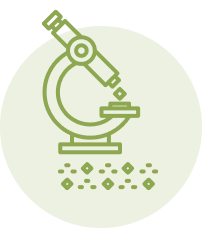Having a healthy soil is the surest way to healthy plants. But what factors are involved in soil health, and what can be done to improve the health of a soil?
“Enhancing soil health — in all its aspects, not just nutrient levels — is probably one of the most essential strategies for providing nutritious food to all the people in the world and ending the scourge of hunger and malnutrition.”
– Building Soils for Better Crops, 3rd edition, 2009, pp 7-8
Key Factors In Soil Health
A healthy soil has good physical structure, with have enough pore space to contain oxygen to fuel the growth of plant roots and soil microbes. Soils with good structure allow water to infiltrate easily without pooling or running off, and they also hold enough water to support good growth of plants and soil microbes.
Healthy soils also require robust microbial activity and diverse microbial populations. A single teaspoon of healthy soil contains between 100 million and a billion bacteria; in an acre of healthy soil, the upper 6 inches will contain up to 23,000 pounds of microbes!
What Soil Microbes Do
Soil microbes play a critical role in soil health, performing numerous important functions. They help soil particles group together to form stable aggregates, improving and maintaining soil structure. They also convert nutrients locked up in unavailable forms into plant-available forms. Mycorrhizal fungi grow into and around plant roots, helping the roots absorb water and nutrients by expanding their surface area. Mycorrhizal fungi can expand a plant root surface area as much as ten-fold! A healthy and diverse microbial population also helps to minimize pest and disease problems.
A robust soil microbial community requires organic compounds as energy sources. Soil organic matter is an important carbon source that fuels healthy microbial populations. Soil organic matter levels are declining overall, in part due to over reliance on synthetic nitrogen fertilizers and regular use of pesticides.
Factors Reducing Soil Health
New homes often suffer from poor soil health. This is because the topsoil (which contains the organic matter) is removed during construction to form a stable construction base. The topsoil is sometimes sold and hauled away as the first revenue from a project. The low organic matter subsoil from basement excavation is often spread over the rest of the yard when construction is complete. This leads to yards and lawn area with very low organic matter and often compaction from heavy equipment used in construction.
Compacted soils have reduced pore space, so water does not infiltrate well, and oxygen levels are reduced. This greatly reduces the growth of plant roots and soil microbes.
Overly acidic (particularly under pH 5.6) or alkaline (pH 8.0 or above) soil conditions will also reduce microbial activity. A slightly acidic to neutral soil pH promotes the best microbial activity in soil.
In addition, regular use of pesticides and synthetic nitrogen fertilizers can have a negative effect on soil health. They can reduce the diversity of the organisms living in the soil, including those that build soil structure. Long-term use of synthetic nitrogen fertilizer speeds up the breakdown of soil organic matter, reducing the carbon sources available to fuel diverse microbial populations that are important for cycling nutrients and protecting plant roots from pests and diseases.
Practices for Improving Soil Health
There are a number of steps gardeners can take to improve and maintain soil health.
Reduce the use of synthetic nitrogen and pesticides in your lawn and garden and replace them with products that work with the soil to improve it.
Regularly add organic matter to soils to ensure good carbon reserves to fuel microbial growth. Earth Science fertilizers contain organic matter produced from composted animal manures combined with minerals, adding carbon to the soil to fuel microbial growth while providing slow release nutrients. Earth Science Earthworm Castings are another excellent source of organic matter, as is compost.
Use organic mulch in gardens to help prevent soil compaction and provide a source of organic matter that will decompose over time from the activity of microbes, earthworms, and other beneficial soil organisms.
Adjust soil pH if necessary. Earth Science Fast Acting™ Lime can be used to quickly and efficiently raise the pH of soils that are overly acidic; Earth Science Fast Acting Sulfur® can decrease the pH of soils. Both products are easy to handle pelleted formulations.
Avoid tilling or digging the soil when it is wet. Disturbing wet soil can harm the soil structure and cause compaction.
Conclusion
It is not difficult to use lawn and garden care practices that work to benefit soil health. Choosing the right products and avoiding practices that are harmful to soil microbes and structure will quickly provide benefits in any lawn and garden.



